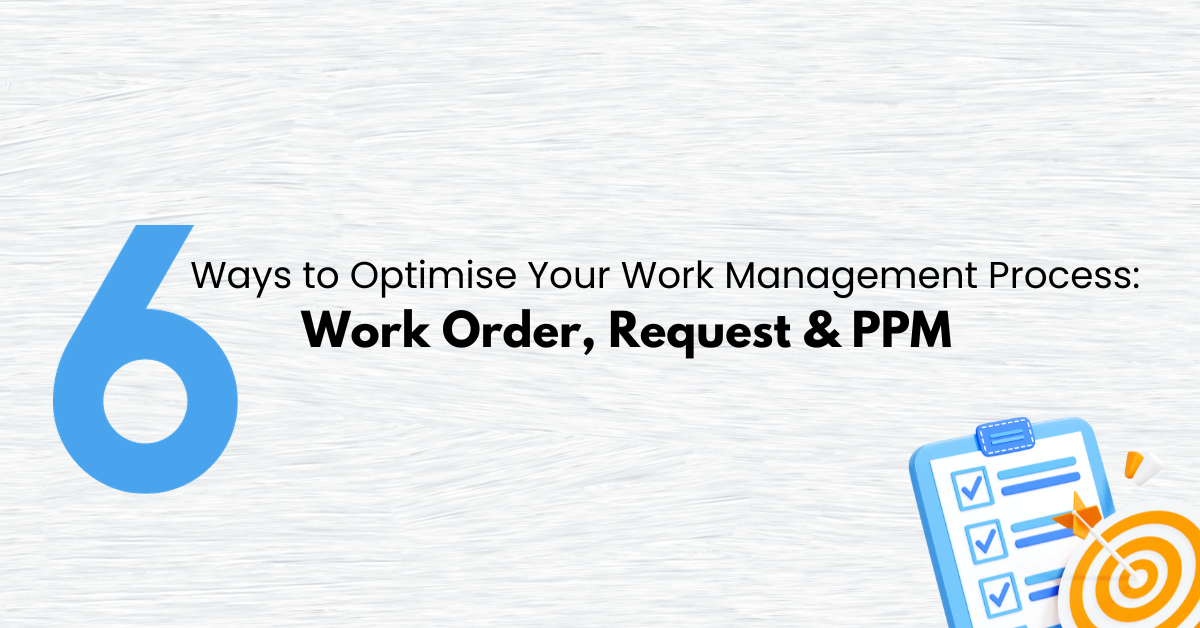Table of Contents
Introduction
In today’s fast-paced business environment, tasks can range from simple to complex. They may involve multiple stakeholders, specialized skill sets, and stringent timelines. Whether in the context of asset management, facility management, or any other industry, work management is vital for several reasons.
It is how your organization manages service requests, work orders, tasks, and routine maintenance schedules for your physical assets like facilities, equipment, machinery, infrastructure, etc…
Asset Managers and Facility Managers follow a work management process to ensure effective scheduling, tracking, and completion of tasks. The objective is to achieve improved efficiency, visibility, resource management, and accountability to maximize productivity and ensure asset longevity.
Why is a Work Management Process Important for Facility Managers and Asset Managers?
1. Optimization of Resources:
Effective work management allows organizations to make the best use of their human, material, and financial resources.
2. Timely Delivery:
Proper task scheduling and monitoring ensure that projects and tasks are completed within set timelines, reducing delays and associated costs.
3. Quality Assurance:
A well-defined work management system can set and maintain standards, ensuring the end product or service meets predefined quality metrics.
4. Accountability:
Assigning and monitoring tasks through a work management system ensures that individuals and teams are accountable for their respective roles, promoting a sense of ownership and responsibility.
5. Transparency:
A robust work management system offers visibility into the work process, allowing for real-time tracking and reporting, which in turn supports data-driven decision-making.
Components of a Work Management Process
A work management process or system can vary based on organization. Here are a few components to remember:
1. Work Requests:
These are the initial submissions that specify a need for work, be it corrective or preventive. They set off the chain of activities within work management.
2. Work Orders:
Once a request is reviewed and approved, it transitions into a work order that outlines the what, who, and when of the work, essentially acting as a formal authorization for work to commence.
3. Planned Preventive Maintenance:
These are proactive tasks designed to maintain assets in optimal conditions, thereby extending lifespan and preventing costly downtime. They are scheduled regularly and are part of the long-term work management strategy.
4. Emergency Tasks:
Unplanned activities need immediate attention and fast-tracking through the work management system.
5. Strategic Initiatives:
These are long-term projects or tasks that align with the organization’s strategic goals and objectives and are managed alongside routine and emergency tasks.
6. Payment:
Upon completion of the repair or maintenance work, payment to the vendors or service providers is approved.
Example of a Work Management Process for Facility Managers
Let’s explore an example of how this would relate to the facility manager of a shopping mall in Nigeria or within Africa.
1. Work Request:
A shop owner reports that the mall’s main escalator is out of order. The mall manager initiates a work request.
2. Work Order:
A work order is generated by the facility manager to repair the escalator and is assigned to the maintenance team.
3. Planned Preventive Maintenance:
The facility manager schedules periodic checks on all mall amenities, such as elevators, escalators, and electrical systems.
4. Payment:
After the work has been completed, the facility manager approves payment, either to an internal team or an external contractor.
Example of a Work Management Process for Asset Managers
Let’s explore an example of how this would relate to the asset manager in a hospital or medical laboratory in Nigeria or Africa
1. Asset Identification:
The process begins with the radiologist identifying a critical issue with a diagnostic machine, for example, an MRI machine showing inconsistent image quality.
2. Assessment:
The asset manager assesses the severity and urgency of the issue. In this case, the poor image quality of the MRI machine could impact patient diagnosis and care, making it a high-priority concern.
3. Work Request:
The asset manager initiates a work request to address the problem. This request includes details about the specific issue, machine identification, and its impact on patient care.
4. Work Order Generation:
Once the work request is received, a work order is generated. It includes the specific tasks required to resolve the issue and is assigned to the biomedical engineering or equipment maintenance team.
5. Equipment Inspection:
The assigned team inspects the MRI machine thoroughly to diagnose the root cause of the image quality problem.
6. Maintenance or Repair:
Depending on the inspection results, maintenance or repair work is carried out promptly.
7. Quality Assurance:
After the maintenance or repair work is completed, the asset manager ensures that the machine undergoes rigorous testing and quality assurance checks. In the case of the MRI machine, this includes running test scans to verify image quality and accuracy.
8. Documentation:
All details of the work performed, including the parts replaced and the repairs made, are thoroughly documented for compliance and future reference.
9. Payment Authorization:
The asset manager reviews the documentation and authorizes payment for the maintenance team or external service providers, if applicable.
10. Preventive Maintenance Plan:
To avoid future issues, the asset manager may initiate a preventive maintenance plan, scheduling regular inspections and maintenance for all diagnostic equipment in the medical centre.

Using a Manual Method for Your Work Management Process Flow?
Managing your workflow and process through manual methods can cause a huge dilemma. Especially in a modern business environment where efficiency, speed, and data are key components of competitiveness and success.
1. Prone to Error:
Processes that could be automated will require human intervention, which is usually slower and more prone to error.
2. Inefficiency:
Tasks like scheduling, resource allocation, and reporting will take longer without technological tools.
3. Reactive vs. Proactive Management:
Lack of a maintenance scheduling system can mean problems are only addressed after they become serious issues.
4. Data Loss:
Data can easily be lost or destroyed without proper digital storage solutions.
5. Lack of Analytics:
Data-driven decision-making becomes challenging without the analytics that technological tools can provide.
6. Coordination:
Without a centralised platform, it becomes challenging to track who is doing what, leading to potential overlap or gaps in responsibilities.
In summary, while avoiding technology may seem simpler in the short term, it can create significant dilemmas that impact efficiency, effectiveness, and competitiveness in the long term.
6 ways to optimize your work management Process
Optimising the work management process can significantly impact operational efficiency, cost reduction, and the overall effectiveness of asset and facility management. Here are some ways you can optimize:
1. Leverage Technology
- Automated Work Requests: Use an automated system where users can log issues. This minimises manual input errors and streamlines the request process.
- Mobile Access: Equip your team with mobile devices that can access the work management system. This allows real-time updates and better coordination.
- Digital Approvals for Payment: Implement a digital invoicing and approval system to speed up the payment process, reducing vendors’ time to get paid.
- Automated Notifications and Reminders: Implement an automated notification system that sends alerts and reminders to relevant parties at various stages of the work management process.
- Reports and Analytics for Quick and Accurate Decision Making: Utilise software that provides comprehensive reporting and analytics capabilities. This allows you to collect and analyze data related to work management, asset performance, and maintenance trends.
With the help of custom reports and analytics tools, you can quickly assess the efficiency of your work management process, identify recurring issues, and make data-driven decisions for process improvement
2. Streamline Processes
- Standardise Templates: Use standardised templates for work orders to ensure all critical information is captured and nothing is missed.
- Batch Similar Tasks: Combine similar work orders to be performed simultaneously to reduce downtime and manpower needs.
3. Enhance Preventive Measures
- Risk-based Maintenance: Prioritise preventive maintenance tasks based on the criticality of assets rather than a fixed schedule.
- Scheduled Audits: Perform regular audits of the preventive maintenance process to identify gaps and areas for improvement.
- Regular Scheduled Inspections: Integrate proactive maintenance processes into your work management system by scheduling routine equipment inspections. These inspections can be conducted at planned intervals, with trained maintenance personnel checking for signs of wear and tear, loose components, or early indications of potential issues.
Proactive inspections help identify and rectify problems before they escalate into costly breakdowns.
4. Training and Skill Development
- Skill Mapping: Ensure work orders are assigned based on the workforce’s skill set to improve efficiency.
- Training Programs: Regular training ensures the team is up-to-date with the latest procedures and technologies.
5. Financial Optimisation
- Budget Tracking: Keep a real-time tab on maintenance costs and budget allocations. Compare actual costs with estimates to keep spending in check.
- Cost-benefit Analysis for Vendors: Periodically evaluate vendor performance and costs to ensure you are getting the best value for your money.
- Leverage good vendor selection and quotation management practices: Implement structured vendor selection criteria and centralized quotation management.
6. Feedback and Continuous Improvement
- Performance Metrics: Implement Key Performance Indicators (KPIs) to measure the effectiveness of the work management process.
- User Feedback: Collect and analyse feedback from the end-users who initiate work requests to identify areas for improvement.
By optimising these areas, you improve the efficiency of your work management process and boost the satisfaction levels of your team and the end-users, all while potentially realizing significant cost savings.
Moving your work management process from a manual process to an automated process with Instanta Facility
Instanta Facility is a technological software called a CMMS(Computerised Maintenance Management System), Asset Management Software or Facility Management Software that significantly enhances the efficiency and effectiveness of the work management process by removing /reducing manual effort and providing actionable insights.
Instanta Facility is cost-effective and has a unified management system that provides real-time analytics to make data-driven decisions. It is user-friendly and accessible via a web portal or mobile app.
It provides an automated workflow from work request and work order management to preventive maintenance schedules and asset lifecycle tracking.
Instanta Facility ensures that your data is safe and ensures your company maintains industry-specific compliance standards effortlessly.
It provides a centralised dashboard for submitting and tracking work requests and work orders, PPM, and payment requisitions.
This solution is tailored to meet the specific needs of businesses in Nigeria and across Africa

A Dashboard:
An interface allows users to view the organization’s metrics, analytics, and recent activities.
Work request:
- Employees within the organization can easily create work requests.
- Access a list of work requests that have been submitted and are currently awaiting approval.
- Approval of work requests is simplified with automatic email notifications and work order creation.
Work order:
- Get a list of work orders on your mobile or web device, whether manually or automatically created.
- It offers an option to include vendors/technicians, items required, cost, and file attachments wherever required.
- Approving work orders is an effortless process on the web and mobile.
- You can also add follow-ups, and comments, or provide feedback.
Pending PPM:
- Create a PPM type to schedule different kinds of preventive maintenance.
- Receive notifications and reminders for PPM close to the due date.
- Automatically generate work orders for preventive maintenance for due PPMs.
To learn more about Instanta Facility, its features, and how it can suit your business needs, click here to request a demo with our business team.
How your team can work together to resolve a request using Instanta Facility
A typical workflow management process can be segmented into the following three:
- Typical work management process flow – Unplanned and vendor quotation NOT required
- Typical work management process flow – Unplanned and vendor quotation required
- Typical work management process flow – Planned (Preventive maintenance)
Below is an example of how your team can work together to resolve a request that doesn’t require a vendor quotation using the CMMS Software Solution; Instanta Facility:
| Role in the Organisation | Action Implemented | Output |
| Requester | Your end-user submits a request via the web portal or app. | The relevant personnel receive an email notification and see the request in their Instanta Facility work request list. |
↓
| Facility / Asset Manager | The officer reviews the request, collaborates using the comment card, and requests additional information. | |
| Facility / Asset Manager | The officer checks the “request approval box” and selects approving officers from the drop-down box | An automated email notification requesting approval will be sent to the designated approving officer. |
↓
| Approving Officer | The approving officer opens the request and grants approval. | If multiple approving officers are involved, the next officer in line receives an email notification to review and approve the request. Once approved, a work order is automatically generated. |
↓
| Facility / Asset Manager | The officer opens the work order, selects the priority level, assigns work, sets start and completion dates, and adds materials & costs manually or directly from the inventory. | The technician or vendor is automatically notified to start execution via email or SMS notification Instanta tracks and displays the SLA status |
| Facility / Asset Manager | On work completion, the operation officer updates the status of the work order to ‘completed | After work completion, the requester automatically receives an email for feedback and rating. Vendors automatically receive work order completion documents by email. The finance team automatically receives a payment request notification with supporting documents to initiate vendor payment. |
↓
| Requester | The requester is notified upon completion of work and given the option to rate satisfaction or reopen the order if not satisfied. | The reopened work order will be sent back to the operation team |
↓
| Account Officer | The account team reviews and approves the payment requisition and pays vendors, updating payment details. |
To access more features suitable to your company/industry-specific need, reach out to our team to request a demo or send an email to – info@sysservesolutions.com or call – +234 (0)703 978 4709.
Instanta Facility isn’t just another tool; it’s a comprehensive solution designed to transform your work management from a cost center into a strategic asset and your partner in achieving operational excellence. By offering a blend of flexibility, power, and convenience, Instanta Facility takes you beyond mere maintenance and asset management—it enables you to achieve operational excellence.
Dive into a more efficient and data-driven future. Choose Instanta Facility, the best CMMS and asset management solution, to manage your assets, streamline your operations, and elevate your work management processes.





















